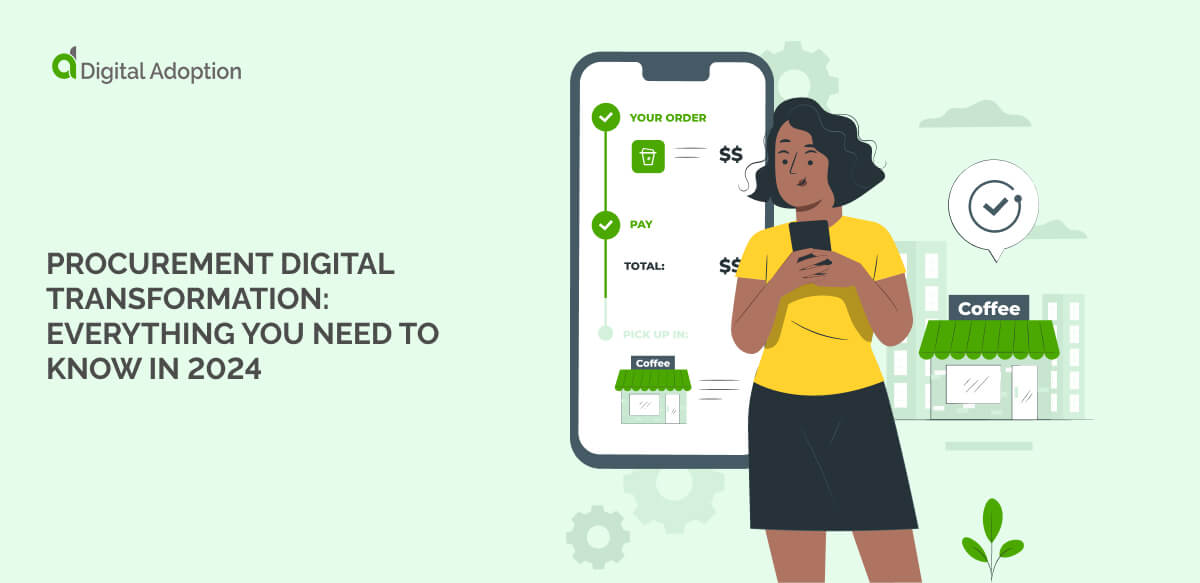Digital transformation can have an impact on every part of the supply chain. The many processes in procurement are no different. This area is ripe for digital transformation: inefficiencies with manual processes, spend visibility, and long cycle times, can all be improved with up-to-date software solutions.
This article will highlight how digital transformation enhances procurement teams’ performance. We’ll discuss technology’s role, benefits, challenges, and emerging trends in procurement. For teams hesitant about digital changes, rest assured: ample support exists for a smooth transition.
This article is about how new technologies are changing the procurement process: it is not about procuring technology. The tech buying process is a separate issue. Procuring disruptive technology, such as Artificial Intelligence, is an important topic we will deal with elsewhere.
What does digital transformation mean in procurement?
When we use the word procurement, we are talking about the overall process of acquiring goods, services, or works from external sources. Procurement involves identifying the need for goods or services, sourcing potential suppliers, negotiating contracts, making purchasing decisions, and managing supplier relationships. It encompasses the entire lifecycle of acquiring goods or services, from the initial request to the final payment.
Across the procurement system, there are many risks of inefficiencies. Of course, traditionally, procurement was a manual process full of inefficient processes. Manual paperwork, fragmented data, and poor spending visibility all created challenges.
Digital transformation (or DX) is implementing technology to achieve business results. It can help procurement professionals to manage complex tasks.
Digital transformation for procurement is not a “one size fits all” process. It could include any (or all!) of the following activities:
- Auditing existing technology systems and software infrastructure
- Implementing new software covering e-procurement, supplier relationship management, and spending analysis
- Rolling out new hardware such as electronic signature devices, barcode scanners, and Internet of Things sensors
- Providing training to staff and vendors on all appropriate systems.
Digital transformation is, at its heart, a major change management process. And to make the most out of digital assets, you need to handle technology and people. So why do leaders choose to start this process?
The benefits of procurement digital transformation
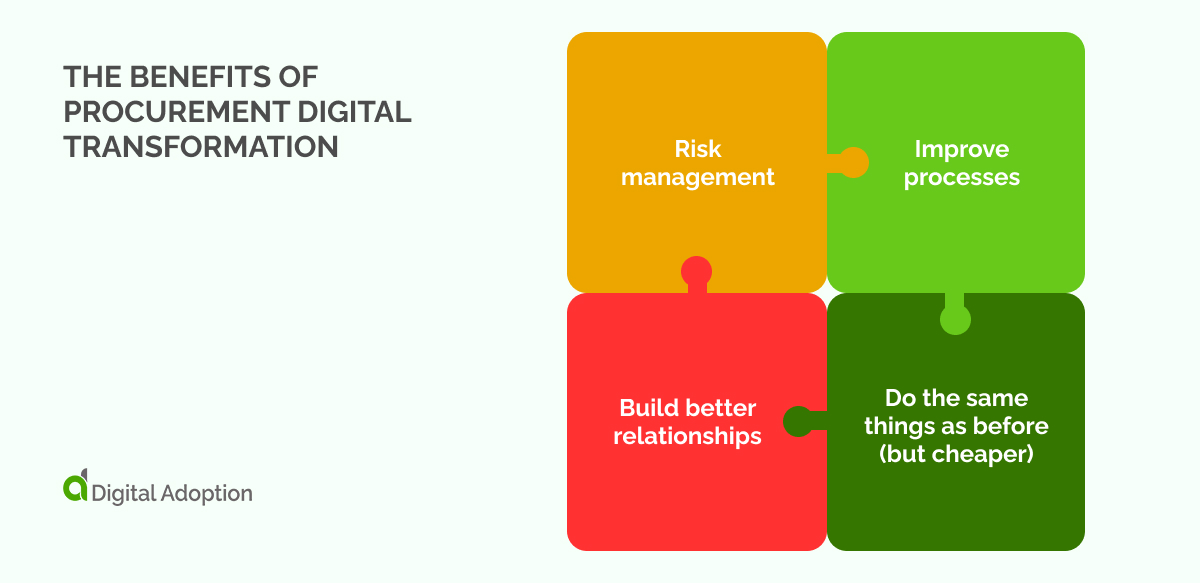
Implementing digital transformation is costly, demanding significant license, hardware, and training investment. But it’s not just hype. E-procurement solutions bring major business benefits. Here, we’ll examine four top reasons for implementing digital transformation in procurement: risk management, process improvement, cost optimization, and relationship building.
Risk management
Better risk management is one of the main drivers for digital transformation in procurement today by providing real-time visibility into supplier performance, compliance, and market conditions. It allows organizations to assess and mitigate risks proactively, such as supplier disruptions, compliance violations, or market fluctuations, through automated alerts, data analytics, and supplier collaboration tools.
Improve processes
As we’ve already mentioned, procurement traditionally involves a lot of inefficient processes. Digital transformation improves process efficiency by automating manual tasks, eliminating paperwork, and enabling streamlined workflows. It improves strategic sourcing, reduces cycle times, minimizes errors, and enhances productivity through features such as e-procurement systems, electronic approvals, automated document management, and real-time data access, resulting in faster, more efficient procurement operations.
Do the same things as before (but cheaper)
Digital transformation in this field can also save costs compared to legacy systems. Digital procurement drives cost reduction by optimizing sourcing strategies, streamlining processes, and enabling data-driven decision-making. It helps organizations identify cost-saving opportunities, negotiate favorable terms with suppliers, reduce maverick spending, and improve contract management, resulting in lower procurement costs and increased savings. Progress in many business areas shows clearly that DX can reduce operational costs dramatically – and procurement is no different.
Build better relationships
Furthermore, there are vendor management benefits to digital procurement. Digital procurement fosters strategic relationship building with suppliers by providing tools for enhanced collaboration, performance monitoring, and communication. It facilitates sharing information, joint problem-solving, and innovation, leading to stronger partnerships, improved supplier engagement, and the ability to leverage supplier expertise for mutual benefits.
Challenges for digital transformation in procurement
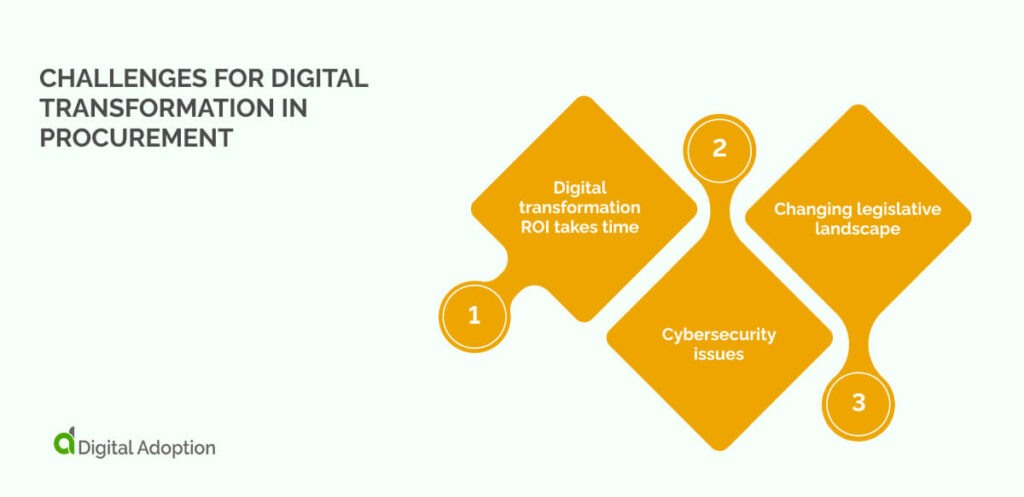
Of course, it’s not easy to produce the best results from digital procurement technology.
Whatever your starting point is, every company needs to implement a solid technology adoption strategy and develop a good understanding of change management principles.
Fortunately, many procurement departments have undergone digital transformation, and we can learn from their successes and failures. There are three key issues: long-term realization of ROI, cybersecurity, and unpredictable legislation.
Digital transformation ROI takes time
Unfortunately, DX is not a quick fix.
A McKinsey guide to digital procurement explains it clearly: “Digital procurement transformation is like a marathon in which many companies drop out of the race early on, failing to get beyond an initial set of pilots.”
There’s no question that DX initiatives in procurement require major investments in technology, infrastructure, and process redesign. As a result, it may take time to fully integrate and optimize these new systems, train users, and overcome any resistance to change. Organizations may experience a delay in realizing the return on investment (ROI) associated with their digital procurement initiatives.
It pays to be patient: but not every company has this resilience.
Cybersecurity issues
Digital transformation introduces new vulnerabilities and risks related to cybersecurity. As procurement processes become more digital and interconnected, organizations must address the challenge of protecting sensitive procurement data from cyber threats, such as data breaches, hacking attempts, ransomware attacks, or unauthorized access. Establishing robust cybersecurity measures, implementing secure systems, and ensuring employee awareness and training are critical to safeguarding procurement data and systems.
Changing legislative landscape
Procurement activities are subject to various legal and regulatory requirements that can pose challenges during digital transformation. Organizations must navigate compliance with data protection and privacy laws, industry-specific regulations, international trade regulations, and other legal frameworks. Adapting digital procurement processes and systems to align with evolving legislation, ensuring data privacy and security, and managing compliance risks are key considerations in the digital transformation journey.
Trends in digital procurement
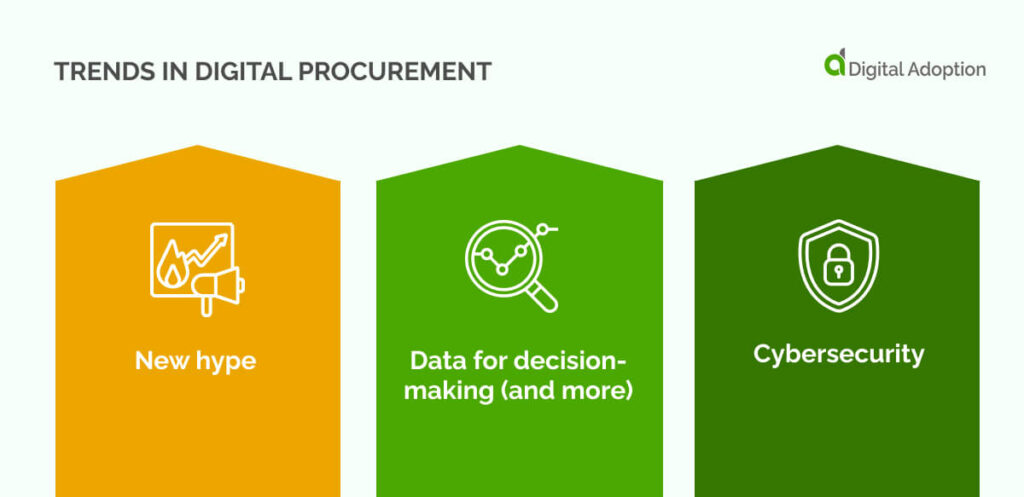
The landscape of digital technology, business priorities, and procurement processes is constantly changing. At the time of writing, three trends are especially important. These include different types of speculation around disruptive technologies, the growing importance of data analytics, and renewed attention to cybersecurity.
Let’s take a look at each aspect in turn.
New hype
The technological hype has changed. The mania for blockchain and NFTs has subsided. Although these technologies offered significant use cases for all aspects of supply chain management, those uses have not taken root in procurement.
But while some people still work away on Web3 applications, speculators are now pointing to the new possibilities of Chat GPT and generative AI for procurement. So, anyone interested in digital transformation for procurement should keep an eye on AI developments – they can significantly change the industry.
Data for decision-making (and more)
Secondly, data analytics continues to prove its worth as a valuable tool. With vast data generated throughout the procurement lifecycle, organizations can leverage data analytics to unlock useful information about supplier performance, spending patterns, market trends, and risks. Data analytics plays a crucial role in the digital transformation of procurement processes, helping leaders to identify cost-saving opportunities, optimize supplier selection, negotiate favorable terms, and enhance overall procurement strategies.
Cybersecurity
Thirdly, as digital transformation expands, the demands on cybersecurity procedures become increasingly important. Cybersecurity is paramount in the digital transformation of procurement processes because it safeguards sensitive procurement data, protects against cyber threats, and ensures the integrity and confidentiality of information. With procurement operations increasingly digitized, the risk of data breaches, unauthorized access, and other cyberattacks rises. Effective cybersecurity measures mitigate these risks, instill trust in supplier relationships, and safeguard the entire procurement ecosystem, enabling organizations to operate securely and maintain the confidentiality, availability, and reliability of procurement data and systems.
The procurement processes of the future
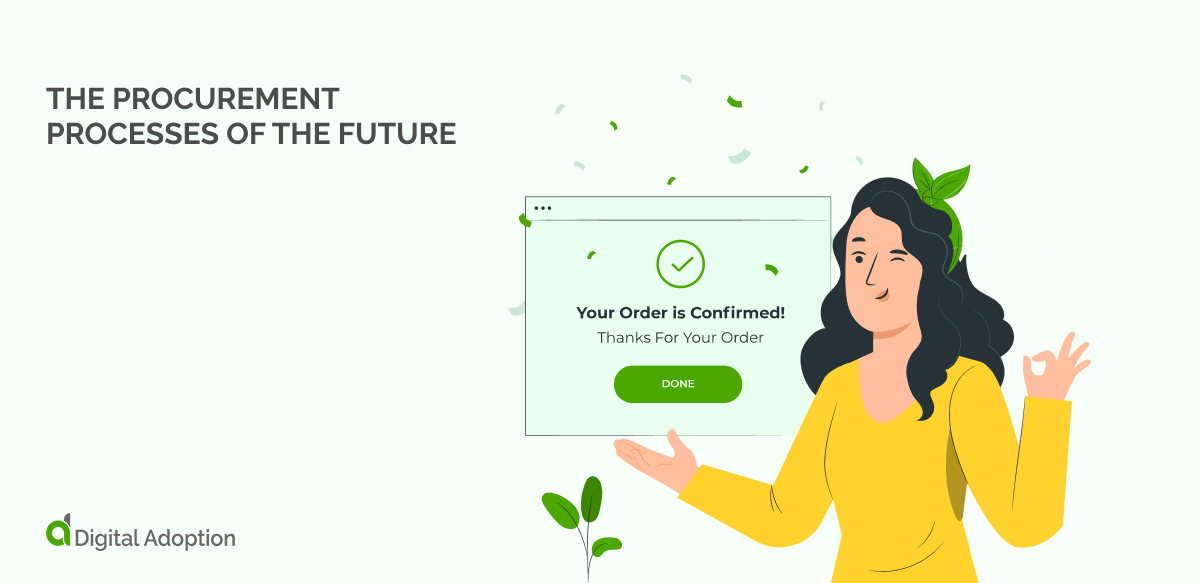
This article has shown you the basis for digital procurement transformation. For a quick reminder, that means:
- Digital transformation has serious implications for procurement
- Successful digital transformation in procurement brings in major benefits (but it is not without its challenges for procurement leaders)
- The landscape of procurement technology is constantly changing (so make sure you stay up to date!).
As a final point, let’s face it: digital workplaces are increasingly complex. Every employee uses multiple digital technologies every day. If you add new procurement software alongside everything else, there’s a high risk of getting things wrong: poor training, inefficient software usage, and more.
That’s where a digital adoption platform can help. It can support your training demands, provide valuable insights into employee usage, and ensure your software solutions run efficiently. A DAP could be your friend if your digital transformation efforts are difficult to monitor.

